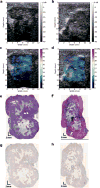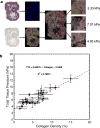Elastographic Assessment of Xenograft Pancreatic Tumors
- PMID: 28964615
- PMCID: PMC5693710
- DOI: 10.1016/j.ultrasmedbio.2017.08.008
Elastographic Assessment of Xenograft Pancreatic Tumors
Abstract
High tissue pressures prevent chemotherapeutics from reaching the parenchyma of pancreatic ductal adenocarcinoma, which makes it difficult to treat this aggressive disease. Researchers currently use invasive probes to monitor the effectiveness of pressure-reducing therapies, but this practice introduces additional complications. Here, we hypothesize that Young's modulus is a good surrogate for tissue pressure because collagen density and hyaluoronic acid, the key features of the tumor microenvironment responsible for high tissue pressures, also affect modulus elastograms. To corroborate this hypothesis, we used model-based quasi-static elastography to assess how the Young's modulus of naturally occurring AsPc-1 pancreatic tumors varies with collagen density and hyaluoronic acid concentration. We observed that Young's moduli of orthotopically grown xenograft tumors were 6 kPa (p < 0.05) higher than that of their subcutaneously grown counterparts. We also observed a strong correlation between Young's modulus and regions within the tumors with high collagen (R2 ≈ 0.8) and hyaluoronic acid (R2 ≈ 0.6) densities. These preliminary results indicate that hyaluronic acid and collagen density, features of the pancreatic ductal adenocarcinoma tumor microenvironment responsible for high tissue pressure, influence Young's modulus.
Keywords: Model-based elastography; Pancreatic ductal adenocarcinoma; Total tissue pressure; Tumor microenvironment.
Copyright © 2017 World Federation for Ultrasound in Medicine and Biology. Published by Elsevier Inc. All rights reserved.
Figures








Similar articles
-
Technical Note: In vivo Young's modulus mapping of pancreatic ductal adenocarcinoma during HIFU ablation using harmonic motion elastography (HME).Med Phys. 2018 Nov;45(11):5244-5250. doi: 10.1002/mp.13170. Epub 2018 Oct 1. Med Phys. 2018. PMID: 30178474 Free PMC article.
-
Noninvasive Young's modulus visualization of fibrosis progression and delineation of pancreatic ductal adenocarcinoma (PDAC) tumors using Harmonic Motion Elastography (HME) in vivo.Theranostics. 2020 Mar 15;10(10):4614-4626. doi: 10.7150/thno.37965. eCollection 2020. Theranostics. 2020. PMID: 32292518 Free PMC article.
-
Elastography Can Map the Local Inverse Relationship between Shear Modulus and Drug Delivery within the Pancreatic Ductal Adenocarcinoma Microenvironment.Clin Cancer Res. 2019 Apr 1;25(7):2136-2143. doi: 10.1158/1078-0432.CCR-18-2684. Epub 2018 Oct 23. Clin Cancer Res. 2019. PMID: 30352906 Free PMC article.
-
[Radiological evaluation of pancreatic ductal adenocarcinoma].Gan To Kagaku Ryoho. 2012 Mar;39(3):342-6. Gan To Kagaku Ryoho. 2012. PMID: 22421758 Review. Japanese.
-
[Ductal adenocarcinoma and unusual differential diagnosis].Radiologe. 2016 Apr;56(4):325-37. doi: 10.1007/s00117-016-0090-1. Radiologe. 2016. PMID: 27000276 Review. German.
Cited by
-
Preclinical Imaging Using Single Track Location Shear Wave Elastography: Monitoring the Progression of Murine Pancreatic Tumor Liver Metastasis In Vivo.IEEE Trans Med Imaging. 2020 Jul;39(7):2426-2439. doi: 10.1109/TMI.2020.2971422. Epub 2020 Feb 3. IEEE Trans Med Imaging. 2020. PMID: 32012006 Free PMC article.
-
Plane-Wave Imaging Improves Single-Track Location Shear Wave Elasticity Imaging.IEEE Trans Ultrason Ferroelectr Freq Control. 2018 Aug;65(8):1402-1414. doi: 10.1109/TUFFC.2018.2842468. Epub 2018 Jun 1. IEEE Trans Ultrason Ferroelectr Freq Control. 2018. PMID: 29993543 Free PMC article.
-
Towards noninvasive estimation of tumour pressure by utilising MR elastography and nonlinear biomechanical models: a simulation and phantom study.Sci Rep. 2020 Mar 27;10(1):5588. doi: 10.1038/s41598-020-62367-3. Sci Rep. 2020. PMID: 32221324 Free PMC article.
-
Technical Note: In vivo Young's modulus mapping of pancreatic ductal adenocarcinoma during HIFU ablation using harmonic motion elastography (HME).Med Phys. 2018 Nov;45(11):5244-5250. doi: 10.1002/mp.13170. Epub 2018 Oct 1. Med Phys. 2018. PMID: 30178474 Free PMC article.
-
High-Resolution Ex Vivo Elastography to Characterize Tumor Stromal Heterogeneity In Situ in Pancreatic Adenocarcinoma.IEEE Trans Biomed Eng. 2020 Sep;67(9):2490-2496. doi: 10.1109/TBME.2019.2963562. Epub 2020 Jan 1. IEEE Trans Biomed Eng. 2020. PMID: 31902753 Free PMC article.
References
-
- Barnes S, Young P, Miga M. A novel model-gel-tissue assay analysis for comparing tumor elastic properties to collagen content. Biomech Model Mechanobiol. 2009;8:337–343. - PubMed
-
- Bernhaus A, Ozsvar-Kozma M, Saiko P, Jaschke M, Lackner A, Grusch M, Horvath Z, Madlener S, Krupitza G, Handler N, Erker T, Jaeger W, Fritzer-Szekeres M, Szekeres T. Antitumor effects of KITC, a new resveratrol derivative, in aspc-1 and bxpc-3 human pancreatic carcinoma cells. Invest New Drugs. 2009;27:393–401. - PubMed
-
- Berry GP, Bamber JC, Armstrong CG, Miller NR, Barbone PE. Towards an acoustic model-based poroelastic imaging method: I. theoretical foundation. Ultrasound Med Biol. 2006;32:547–567. - PubMed
-
- Boucher Y, Kirkwood JM, Opacic D, Desantis M, Jain RK. Interstitial hypertension in superficial metastatic melanomas in humans. Cancer Res. 1991;51:6691–6694. - PubMed
Publication types
MeSH terms
Grants and funding
LinkOut - more resources
Full Text Sources
Other Literature Sources
Medical

